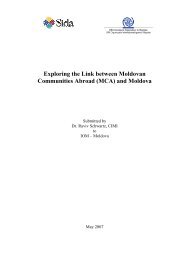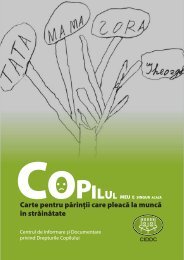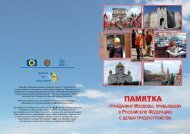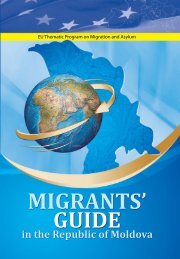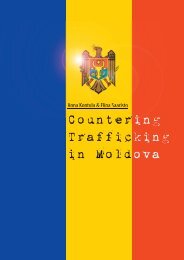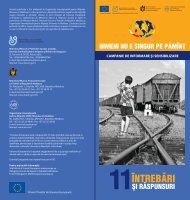specific needs of children and elderly left behind as a ... - IOM Moldova
specific needs of children and elderly left behind as a ... - IOM Moldova
specific needs of children and elderly left behind as a ... - IOM Moldova
You also want an ePaper? Increase the reach of your titles
YUMPU automatically turns print PDFs into web optimized ePapers that Google loves.
Policies <strong>and</strong> mechanisms existing on the protection <strong>of</strong> <strong>children</strong> <strong>and</strong> the <strong>elderly</strong><br />
tially addresses the issue <strong>of</strong> the <strong>elderly</strong> <strong>left</strong> <strong>behind</strong> by migrant family<br />
members: “within this department we analyse all the documents <strong>and</strong> suggestions<br />
from other relevant institutions dealing with these groups. We do<br />
not have special documents for particular services designed to this category<br />
<strong>of</strong> <strong>elderly</strong>” (III_EC_4).<br />
Hence, we can <strong>as</strong>sert that both state departments, <strong>as</strong> well <strong>as</strong> those<br />
operating at the local level (medical <strong>and</strong> social <strong>as</strong>sistance), that are<br />
relevant to providing services to the <strong>elderly</strong> <strong>left</strong> <strong>behind</strong>, do not set<br />
down services specially designed to cater for this category. In both<br />
c<strong>as</strong>es services are provided to the <strong>elderly</strong> <strong>left</strong> <strong>behind</strong> by <strong>children</strong> <strong>as</strong> a<br />
consequence <strong>of</strong> migration alongside other <strong>elderly</strong>, pensioners <strong>and</strong> the<br />
disabled.<br />
• Forms <strong>of</strong> support, social services <strong>and</strong> institutions providing these services<br />
The existing system <strong>of</strong> social services creates opportunities for social inclusion<br />
<strong>of</strong> the <strong>elderly</strong> whose <strong>children</strong> are working abroad. Pointing out the<br />
fact that there are no social services <strong>specific</strong>ally designed for this category,<br />
still they can benefit from social services provided to the <strong>elderly</strong>, disabled<br />
people <strong>and</strong> pensioners. It is <strong>specific</strong> that “the individualized approach <strong>of</strong><br />
<strong>needs</strong> is used regardless <strong>of</strong> the category <strong>of</strong> the socially vulnerable group”<br />
(III_EE_7). Thus, the types <strong>of</strong> social services the <strong>elderly</strong> can apply for are<br />
cl<strong>as</strong>sified in primary social services (community), specialized social services<br />
<strong>and</strong> social services with a high degree <strong>of</strong> specialization. Explaining<br />
the way <strong>of</strong> providing these services designed for the <strong>elderly</strong>, the experts <strong>of</strong><br />
the relevant ministry emph<strong>as</strong>ize the “existence <strong>of</strong> a mechanism <strong>of</strong> providing<br />
social services to these beneficiaries within this system but I stress that we<br />
do not develop services <strong>specific</strong>ally for this category <strong>of</strong> <strong>elderly</strong> <strong>left</strong> <strong>behind</strong> by<br />
migrant family members” (III_EE_7).<br />
The local public authorities <strong>of</strong> the first level (community <strong>and</strong> municipality<br />
councils) identify social issues, administrate local funds for social <strong>as</strong>sistance,<br />
develop <strong>and</strong> financially support community social services <strong>as</strong> well<br />
<strong>as</strong> establish the partnership with NGOs in order to exp<strong>and</strong> social services.<br />
At this level community social services are developed.<br />
Primary social services represent the support for the <strong>elderly</strong> <strong>left</strong> <strong>behind</strong><br />
by migrant family members. Therefore, we can mention social home-care<br />
service (provided by social workers), community social <strong>as</strong>sistance service,<br />
social canteen services <strong>and</strong> services provided by the community.<br />
Social home-care services designed for the <strong>elderly</strong> are <strong>of</strong>fered by social<br />
workers: “it is more difficult to meet their dem<strong>and</strong>s in the private sector <strong>as</strong><br />
the distance is longer although it is e<strong>as</strong>ier <strong>as</strong> they know each other; we visit<br />
211



